.
Thousands of aligned holes in Peru’s Pisco Valley have attracted the attention of archaeologists
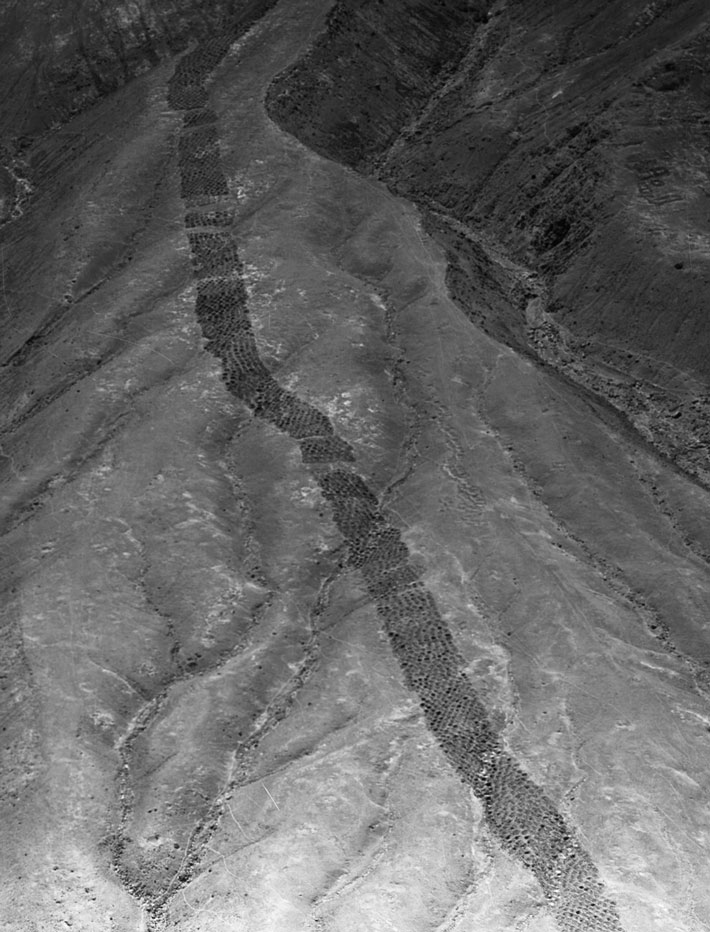
Together, Stanish and Tantaleán speculated as to what the Band of Holes might have been. They reasoned it could have been part of a defensive structure, or served as a marker for a trail, or might even be a geoglyph in the tradition of the nearby Nazca lines. In searching the archaeological literature, they found that the site had first been documented in 1931 by aerial photographer and geographer Robert Shippee. Since then, a few archaeologists had visited and described it as being made up of segments of shallow holes running a mile up a hill known as Monte Sierpe. The consensus seemed to be that the holes were made to store something, but exactly what remained unclear. Despite the fact that previous generations of archaeologists knew about the site, no excavations had been conducted, and no obvious artifacts had been found near the holes. There was no agreement on when it was built or by what culture. For Stanish and Tantaleán, the mystery was deepening.
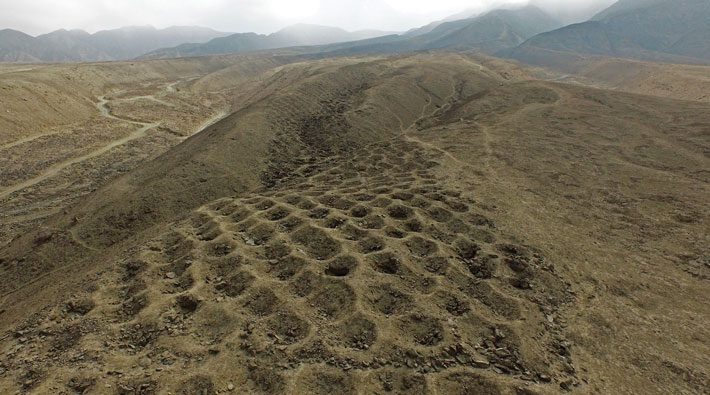
In the 2015 field season, Stanish set up his team in the Chincha Valley and then drove with Tantaleán to Monte Sierpe. From below, the row upon row of holes creeping up the slope made for an imposing view. “Really, it is very impressive,” says Tantaleán. “I’d never seen anything like it in my entire career.” They quickly found a small amount of pottery dating to just before the time the Spanish invaded Peru, when the Inca ruled this part of it. There were also other signs it could be an Inca site. “I began to suspect it dated to the Inca period because at the base of the site there are tombs similar to those in the Chincha Valley that date to the time of the Incas,” says Tantaleán.
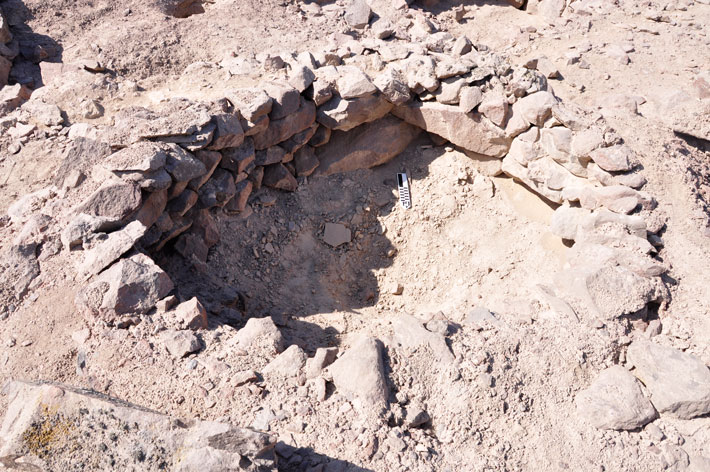
The holes are on average about 3 feet wide and between 20 and 40 inches deep. They may have been used to measure produce being paid to the Inca state as tribute.
A survey showed that most of the holes were about three feet across and 20 to 40 inches deep. They were made in various ways, some dug into artificial mounds of soil and others made up of small rock structures on the surface. None were dug into the hill’s volcanic bedrock, as some who believe in their extraterrestrial origin claim. The archaeologists also noted that the band is divided into several unique groupings, which they called blocks, each of which have different patterns of holes.
Using a drone, they collected aerial images and created a new, detailed map of the Band of Holes, which they estimate is made up of between 5,000 and 6,000 depressions. While others have maintained that the sheer number of holes makes it unlikely that prehistoric people could have constructed it on their own, Stanish calculates that if created all at once, the band could have been completed by a team of 100 workers in a month. A smaller group of 10 workers could have made it in perhaps 300 days, though it’s likely the holes were dug gradually over a long period of time. As impressive a feat as the Band of Holes appears, a well-organized group of people would have had no trouble creating it.
After surveying and studying the site, Stanish began to think that their initial hunch that it dated to the period when the Inca had conquered the area was right. They found not only the remains of an Inca road nearby, but also a series of colcas, Inca-period storage houses. Together with the discovery of Inca-period pottery near the band, these finds seem to suggest that the Band of Holes dates to sometime around the fifteenth century, after the Inca Empire conquered the Chincha people, who were native to the region. “It was all circumstantial,” says Stanish, “but it seemed to fit.” They also felt the holes were once used to store something, but just what and why still wasn’t clear
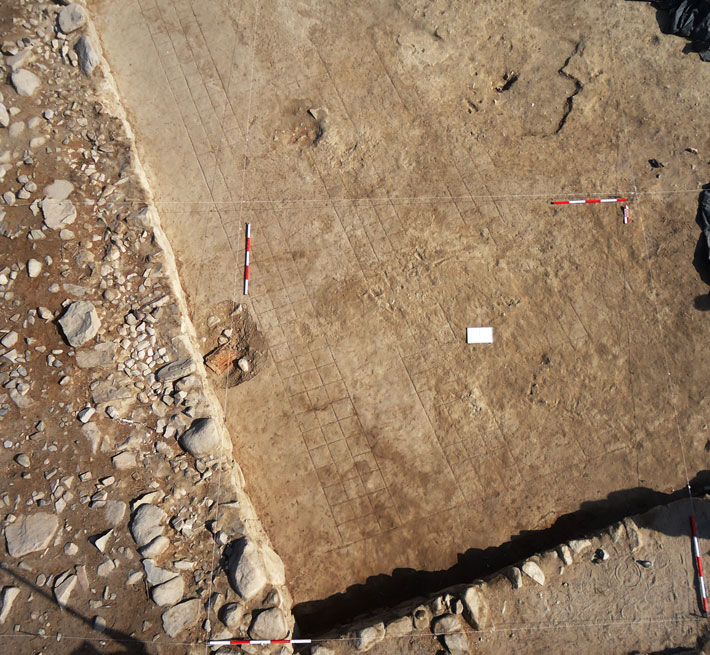
The floor of a recently excavated Inca storehouse at the site of Inkawasi is divided into a checkerboard pattern used as a means of tallying tribute.Back at UCLA, Stanish attended a lecture given by Harvard University archaeologist Gary Urton. Urton spoke about recent discoveries at the Inca site of Inkawasi, which is about 75 miles north of Monte Sierpe. The Peruvian archaeologist Alejandro Chu had found a number of the knotted-string recording devices known as khipus in colcas there. Many of the khipus were associated with the remains of various agricultural produce, such as peanuts and chilies, that had been laid out on a floor that was divided like a checkerboard (see “Reading an Inca Archive,” March/April 2016). Farmers would have brought produce to the colcas as tribute to the Inca state. Urton and his colleagues speculate that each nine-by-nine-inch square in the checkerboard was used to measure the specific amount of tribute owed by each farmer or family. An official state accountant, known as a khipukamayuq, or a “khipu reader,” then recorded the tax on a string.
Stanish was impressed, and immediately saw a similarity between the Inkawasi checkerboard and the layout of the Band of Holes. “They had a really good explanation for how these squares would have been used to measure tribute,” says Stanish. “It seemed likely to me that the holes at Monte Sierpe could have been used to measure out tribute as well.”
The rest of the puzzle began to fall into place. Stanish notes that Monte Sierpe is only four miles from Tambo Colorado, a massive fifteenth-century Inca administrative center built above the agriculturally productive Pisco Valley. The Band of Holes is constructed along a road leading from the valley floor to Tambo Colorado. “It’s the perfect place to stop, measure your produce, and make sure you have the proper amount of tribute,” says Stanish. He thinks that each individual block of holes might have belonged to a different extended family, or ayllu, that would have been a distinct tax-paying group. “You may have had each social group come up and fill up their block with squash, maize, or any other produce in front of the state’s accountants, who could have been keeping a tally with khipus. The goods could have then been taken to Tambo Colorado, or wherever else the authorities wanted to take them.”
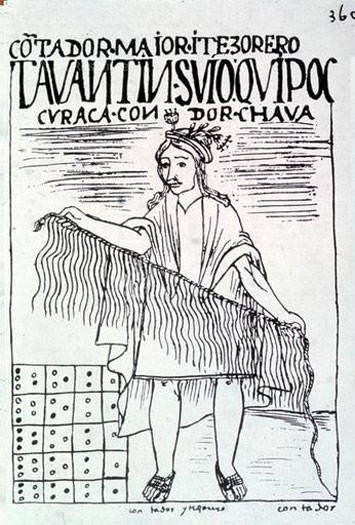
An Inca official displays a khipu, or string-recording device, in this depiction from a Colonial-era chronicle of Andean history.If, in fact, the thousands of holes at the site were dug in order to measure tribute, the Band of Holes might be suggestive of the inner workings of the Inca Empire. “Troops were, of course, the blunt force of the state’s power,” says Urton. “But it was the khipukamayuqs who really established and maintained control over the regions.” Simply being conquered by the Inca didn’t make one a citizen of the empire, but paying taxes certainly did. And pouring beans and chilies into holes in front of state accountants would have brought the average farmer in the Pisco Valley face to face with the power of the state. “Inca accounting practices were the keys to maintaining control over the empire,” says Urton. “Khipukamayuqs really shaped the world of the Incas’ subjects.”
Stanish points out that as strong as the Inca state was, it was a far-flung empire, and its separate regions retained some autonomy. The fact that no exact parallel to the Band of Holes has yet been found may be because administrators in the Pisco Valley devised a local solution to the problem of measuring tribute. “The farther you get from the big Inca centers and Machu Picchu, the more local influences become apparent,” says Stanish. “Monte Sierpe may have satisfied a very local need.”
Stanish hopes to have a graduate student continue research at the Band of Holes, with excavation of carefully selected sections a priority. If the depressions were indeed used to measure produce, they could still hold pollen or even phytoliths, the telltale bits of silica in plant tissue that can allow archaeologists to detect the presence of particular species. “We need to find some phytoliths of maize, beans, squash, or peppers,” says Stanish. “That could help clinch it.”
Stanish will need to produce hard evidence to convince his fellow scholars. Jean-Pierre Protzen, a specialist in Inca architecture at the University of California, Berkeley, has his own theories about Monte Sierpe. Protzen has spent years working at Tambo Colorado, and feels the Band of Holes is not contemporaneous with the massive Inca center. “There are other, earlier major sites close to Monte Sierpe that could have been associated with it,” says Protzen. He thinks the holes may have been used to store guano, an important fertilizer. “It’s amazing visually,” says Protzen, “but we still don’t know much about it.”
Stanish agrees that his hypothesis needs to be tested. “Sure, it’s speculative,” he says. “But we could be on the cusp of a whole new understanding of Inca accounting.” He points out that other sites in the area with unusual alignments that have traditionally been considered religious might also have had roles in administering the tribute system. “If I’m right, then we’re going to have to think differently about a lot of sites that have been regarded as strictly ritual,” says Stanish. Should his theory about the site be proved, the Band of Holes will stand as a monument to the idea that for the Inca, too, death and taxes were the only certain things in life.
Quelle: ARCHAEOLOGY
